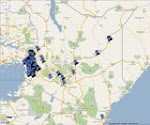When sensitisation really matters...
The results of an ex-post evaluation of an EcoSan Promotion Project.
Posted by Cecília Rodrigues according to the GIZ Report produced by Doreen Mbalo and Kathrin Brand (31 July 2012).
Frequently failures on EcoSan projects are attributed to the users, their acceptance and their inability to use the facilities provided properly. This ex-post evaluation report reminds us that good community work can make a difference in project implementation and impacts directly on its results, including issues like acceptability and the sustainability of the sustainable sanitation practices.
The hard facts. The EcoSan Promotion Project (EPP) was developed from November 2006 to June 2010 in Kenya as a project component of the GIZ Water Sector Reform Program. The project with funding from the European Union, SIDA and GIZ, worked in close partnership with the Ministry of Water and Irrigation (Maji House). During the project, 804 double vault Urine Diverting Dehydrating Toilets (UDDTs) and 13 Decentralised Treatment Systems (DTS) were installed. 541 UDDTs were built in households and 263 in institutions. In total, there were 51,600 users. The project focused on rural household and school based sanitation but also implemented toilets on public places like bus stations and institutions like prisons. Many engineers, artisans and professional companies were trained in the sensitisation, planning and the construction of the EcoSan facilities.
The evaluation. During ten days in June 2012, two years after the project conclusion, 53 EcoSan facilities on a household level were visited. The visits took place in the clusters of Homabay, Kisumu, Chwele, Ugenya, Mumias, Siaya, Ugunja, Semenya and Ukwala in coordination with the local experts Wycliffe Osumba and Moses Wakala. Out of them, 38 toilets were being used and functioning well. The majority of the consulted users were satisfied with their facilities, especially with the application of the compost and collected urine in their farms, meaning that waste was acknowledged as a resource. The possibility of reuse of the faecal matter as well as the noted benefits of its usage turned out to be a further incentive for sharing the household’s facilities amongst neighbours. Furthermore, cleaner surrounding environment and shared maintenance of the facility were also mentioned as advantages. The complaints were mainly related to urine pipe blockages and termites attacking and damaging the wood material used in the construction of the vaults.
 |
| Inspecting the texture of the fertilisers in a dehydration vault. |
 |
| Right section of the maize received fertilizer from UDDTs. |
By comparing the evaluation of the visited toilets, in the cases in which the toilets demonstrated poor results a correspondence can be established with a poor quality of facilitation processes, such as little community mobilization and sensitisation, ownership building and follow up visits by the facilitator. Users were unaware of appropriate toilet use, there were no explanatory posters and they were poorly maintained, facts attributed to “a clear lack of sensitisation and public awareness creation”. Also, from the technical point of view, unfinished and badly constructed facilities demonstrated a need for monitoring and evaluation in all phases of the implementation process.
 |
| User inserted pipes in the dehydration chamber leading to an offset pit. |
 |
| An UDDT used as a pit latrine. |
The conducted evaluation did not assess the facilities built in schools and other institutional settings. However there was a recent evaluation done by a Finish Master student with support by GIZ and local experts, which was posted on this forum here. The report also does not mention how the evaluated facilities were selected. Nonetheless the findings are still relevant. The report confirms the importance of not only building facilities, but also carrying on evaluations during project implementation as well as after its completion. Additionally, it reiterates the importance of software components in the projects: “in the areas where appropriate sensitisation and community mobilisation took place, there were no problems of misuse and acceptance.”
The complete report can be downloaded from SuSanA Library.





Dear All,
You can find the link to the full report here: http://www.susana.org/lang-en/library?view=ccbktypeitem&type=2&id=1579
Best regards,
Doreen